Uncategorized
How Abe Kugielsky’s photos of Hasidic Brooklyn ended up on display in Grand Central Terminal
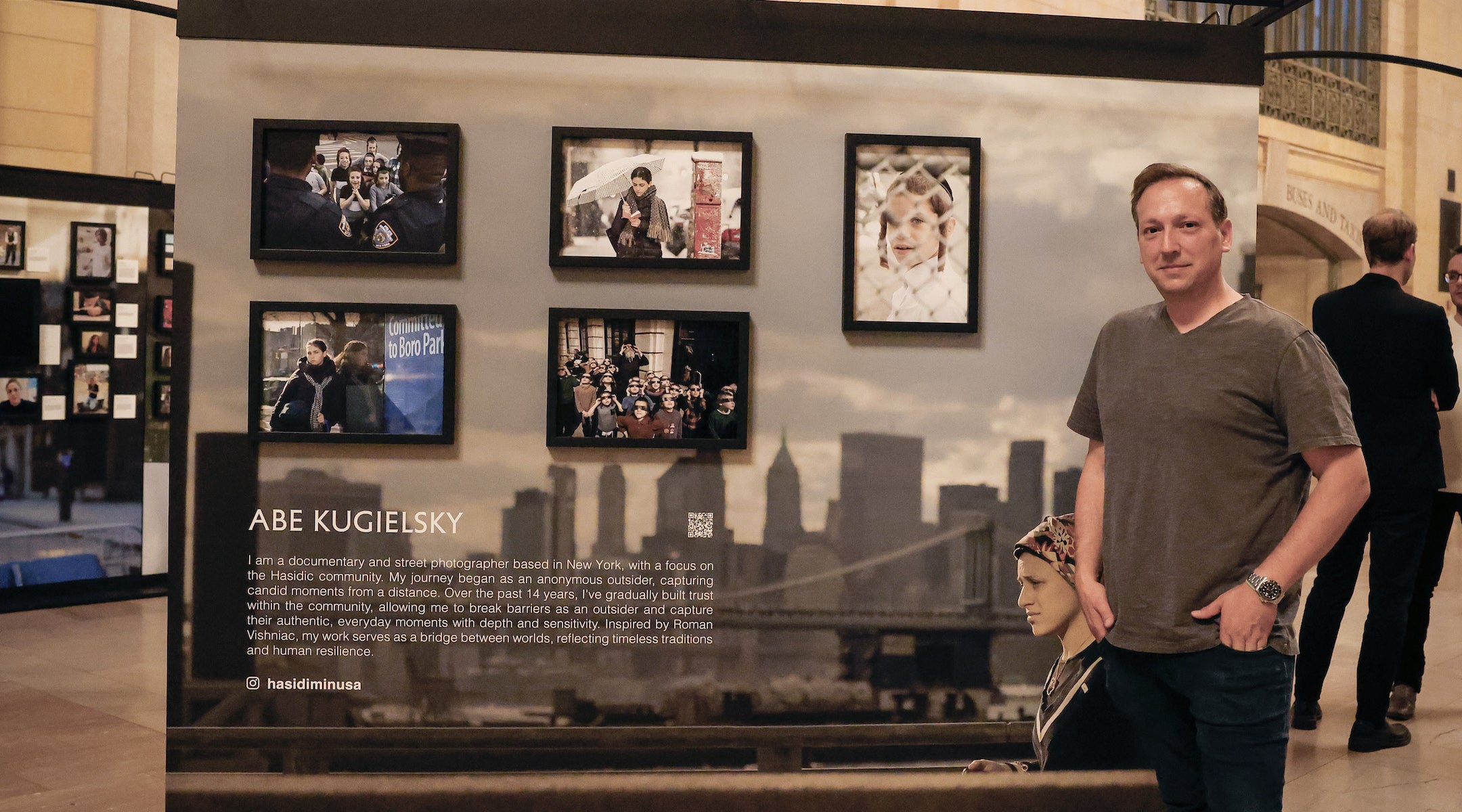
When Abe Kugielsky first began photographing the Hasidic Jewish community in Borough Park, Brooklyn, in 2010, he was an outsider with a camera, met with resistance from a community unaccustomed to being documented.
But by 2017, he had amassed a bank of roughly 50,000 photographs, and decided it was time to start posting his images to an Instagram account he called “Hasidim In USA.”
Today, his account has drawn 80,000 followers curious for a glimpse inside a traditionally private world. And this month, it has also landed him a place in Humans of New York’s “Dear New York” exhibition in Grand Central’s Vanderbilt Hall. The free exhibition, curated by Brandon Stanton of the online photo sensation Humans of New York and including dozens of local photographers, runs until Oct. 19.

A view of Humans of New York’s “Dear New York” exhibition in Grand Central’s Vanderbilt Hall, running from Oct. 6 to Oct. 19. (Courtesy Abe Kugielsky)
By day, Kugielsky, who is 45 and identifies as Modern Orthodox, runs a Judaica antique auction house in Cedarhurst, Long Island. But his photography, and efforts to gain inroads in the Hasidic community, have become his true passion.
“Judaica is my full-time job, but I will close shop whenever I feel like I need a day off to go,” said Kugielsky. “It’s very therapeutic to me when I go out to shoot, I’m in my own little bubble, my own zone.”
This interview was condensed and lightly edited for clarity.
JTA: What first drew you to photographing the Hasidic communities in New York?
Kugielsky: When I moved to Brooklyn after we got married, my wife had a job in Borough Park. I would drive her to work every day. I had started street photography as a hobby back in Israel a little bit, and then got married and I let go of it. But when I started visiting Borough Park every morning, and I was getting that Roman Vishniac vibe by seeing the scenes, and I figured, I’ll pick up a camera and start documenting something that’s been untouched in New York.
It’s been very popular in Israel. There’s so many photography books on Orthodox life in Jerusalem, but there’s nothing about Hasidic life in America. There’s one book from like 1974, a small book with some photos, but that’s about it. It’s really very little. So I felt like it was an untouched niche, and I picked up a camera and I started photographing.
How do you build trust with your subjects in a community that is often described as insular?
To see someone walking on Borough Park with a camera taking pictures is not common. It’s not Mea Shearim [the Jerusalem neighborhood] where we have tourists and Americans and photographers. This is very uncommon, so there was a lot of fear of resistance, and of course, the resistance came. So it started off really more in hiding from distance, and over time, I built trust in the community to a point where they celebrate me.
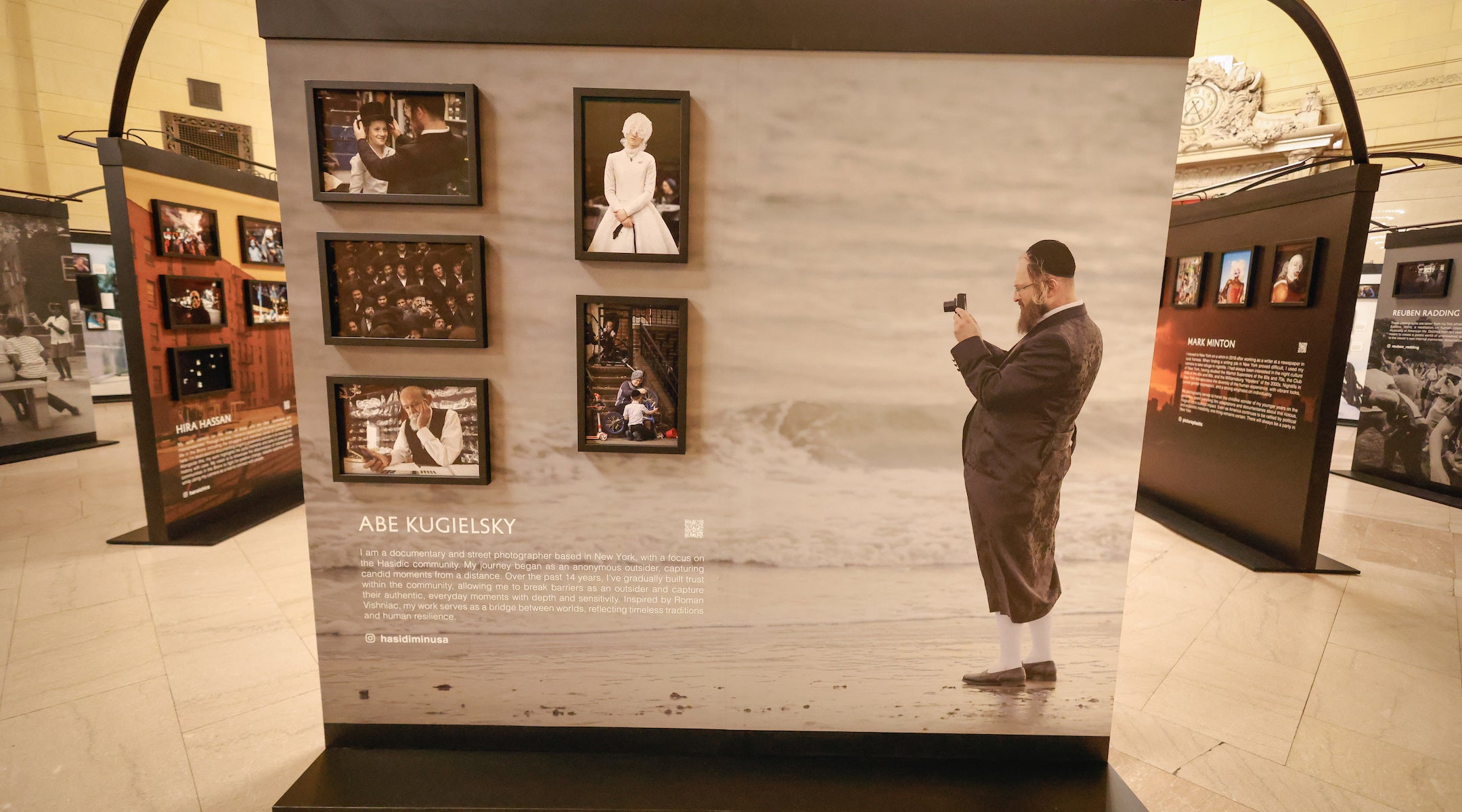
Abe Kugielsky’s installation at Humans of New York’s “Dear New York” exhibition in Grand Central’s Vanderbilt Hall, running from Oct. 6 to Oct. 19. (Courtesy Abe Kugielsky)
I made it my goal to post in a very positive light, either a positive caption or a positive scene or a positive story, to show them I’m not here to bring out what everyone else has been doing. I realized over the years that it’s really rooted a lot in generational trauma, where, whenever media came into Borough Park or Williamsburg, it was always for a negative story, and that’s where the resistance really came from. So over time, when they recognized that my work is not with that goal, they started to appreciate it more and more.
Can you tell me more about the response from the Hasidic community to your work?
I started off with an article in a local Yiddish magazine, and then a couple of months later, another article and I came out publicly with my name, my identity, so people started recognizing me more. And over time, I started getting more and more positive feedback.
I remember a woman in Williamsburg stopped me once, and she said, “I want to tell you that your photos made me fall in love again with my own culture.” So it really had a certain impact on the community, recognizing that these photos tell a positive story. It tells the story of the community that no one else does in a positive light.
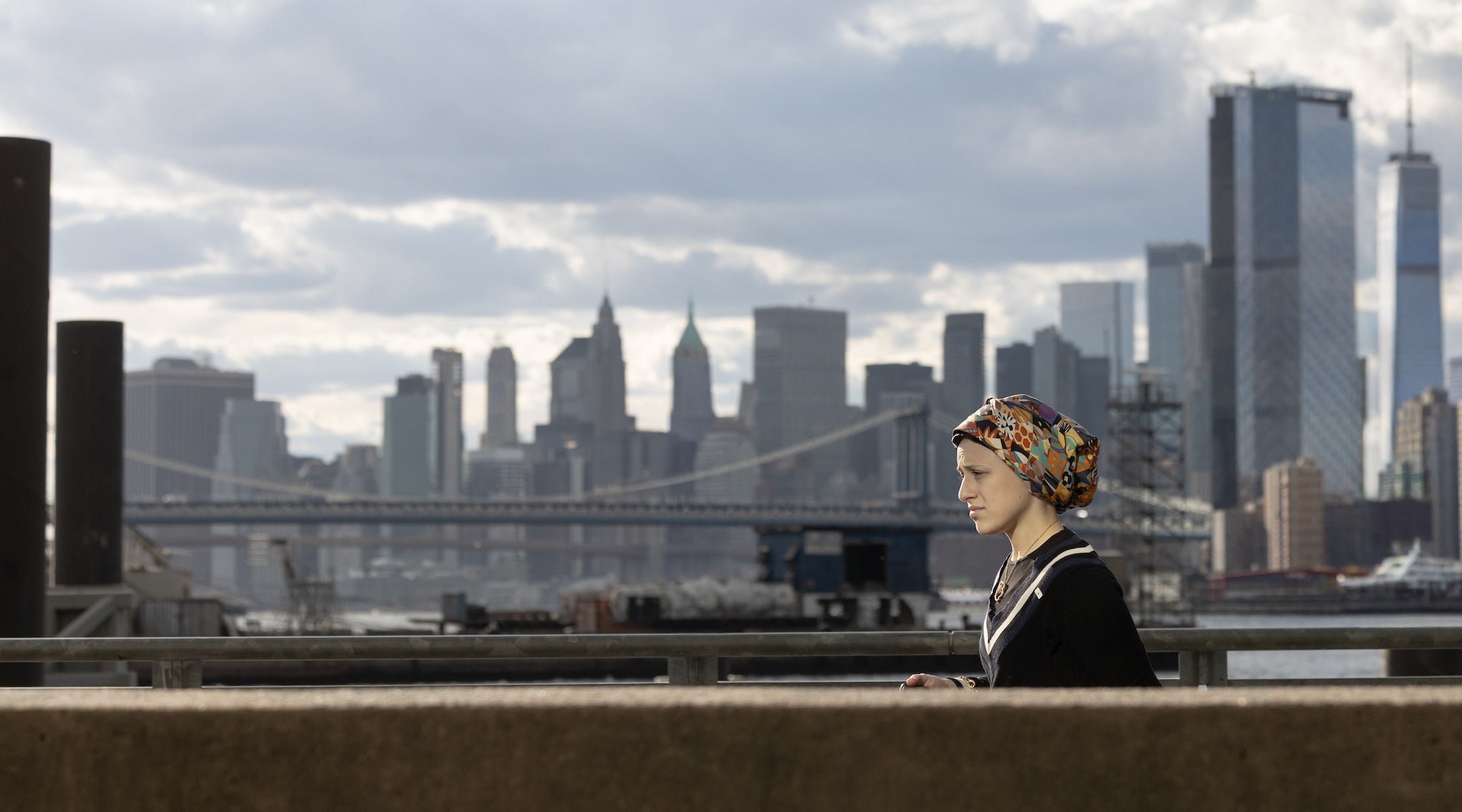
“A Bridge Apart” by Abe Kugielsky. (Courtesy Abe Kugielsky)
It really shifted to the point where, if I walk down Williamsburg, people stop me and ask me for a selfie, and people will DM me and say, ‘Hey, there’s an event going on here, please come down and photograph.” My goal was to go in deeper and deeper, more and more intimate, and I’ve gotten there. Especially this past summer, we had some invites into family life, which is a whole new level that I’ve been really trying to get to.
What kinds of reactions from the public to your work have surprised or challenged you?
Of course, I get a lot of antisemitic comments from time to time with DMs. Anyone who posts anything Jewish nowadays gets them, but I’ve had a lot of interesting positive feedback from non-Jews worldwide. I’ve had people in Iran reach out to me, and I’ve heard from people in Middle Eastern countries, in Germany, Poland. I think they love the concept where they can look into another culture, have a window into another culture, something they don’t get to see.
Do you have a favorite image from the exhibit, and what makes it stand out to you?
I have one great image that I really, really love. This was a silver shop in Borough Park I walked into and I asked the owner, an older Hasidic Jew, if I can photograph him, and his response is, “What do I need it for?”
I have an album on my phone with photos I downloaded from Brooklyn Public Library, old images from Williamsburg taken by a photographer in 1964, and I figured, let me show him what it looks like looking back at photos from 50 years ago. I started showing him on my phone. He was scrolling through the photos, and I said, look how beautiful it is to look at pictures from 50 years ago.
But then he froze on a certain picture, and his demeanor changes, and he goes, “This is my wife.” He found a picture of his wife and his first newborn son from 50 years ago in those photos, so I captured that moment where he’s really reminiscing about those years.
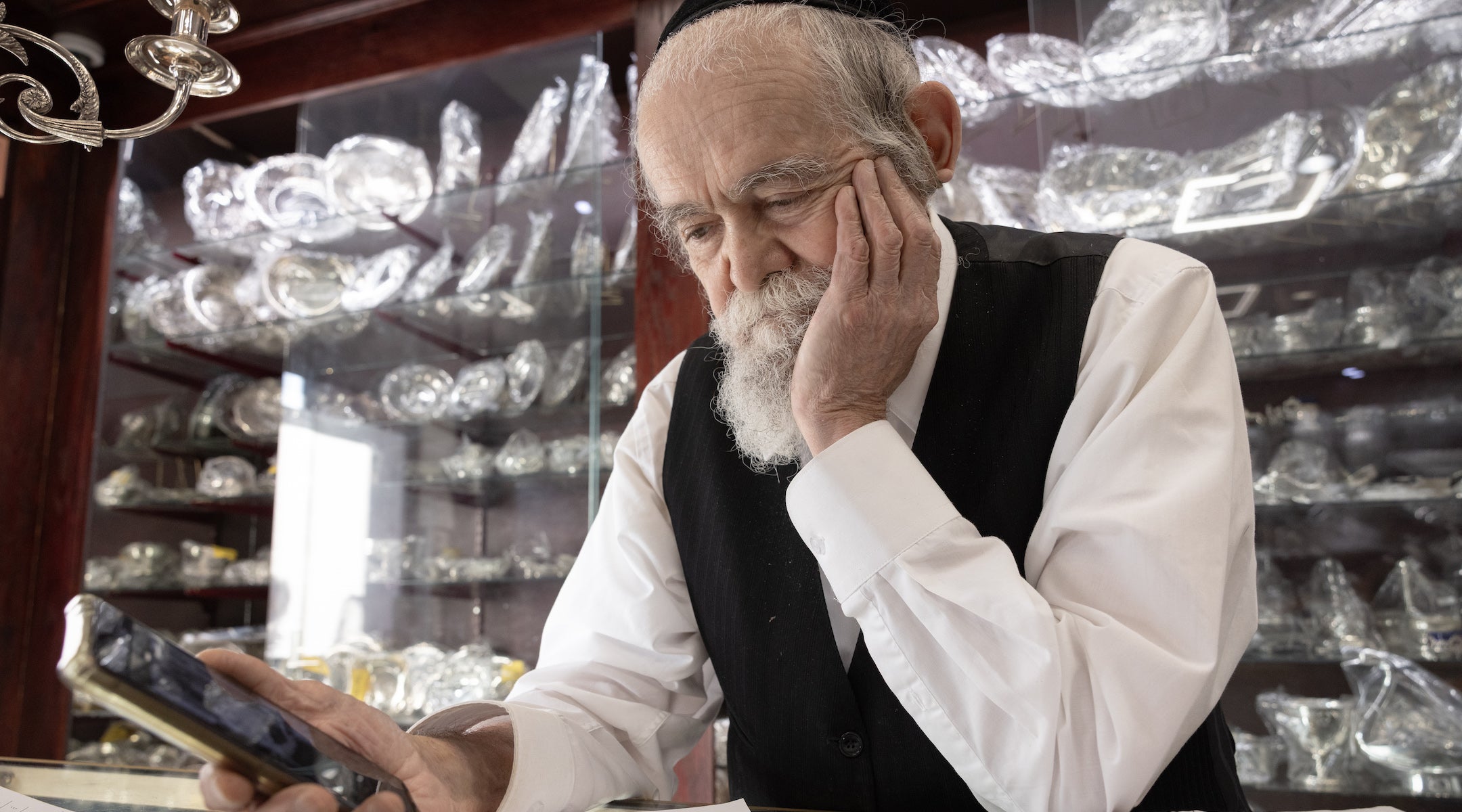
“Silver Memories” by Abe Kugielsky. (Courtesy Abe Kugielsky)
Humans of New York has drawn criticism for a series focused on aid workers in Gaza as well as for featuring a member of Neturei Karta, a small anti-Zionist sect of the Orthodox community. Was that something you thought about before deciding to participate?
I was tagged when he posted his request for people to submit. I didn’t follow him, it’s just not really my style of work, he’s more storytelling. I went into his page, and I saw all these posts, I wasn’t sure what to make of it.
The vibe that I got was I didn’t feel an antisemitism there. I felt like he was more going with the trend, showcasing Palestinians from Gaza or Neturei Karta, more from a place of ignorance.
I believe a lot of New Yorkers, a lot of Americans, a lot of people worldwide, don’t really know and understand the conflict. It’s just in style now to hate, and it’s in style now to side with one side or the other without really understanding.
I didn’t give it a lot of hope when I submitted my photos, and I was actually surprised that he chose my photos to be included, and throughout my conversations with him, I understood that he really doesn’t understand much of the conflict.
Have you received any critical feedback about your involvement in this project?
Very, very little. I think one or two people commented like, why would you do this? But for me, A, It’s an opportunity for me, for my work, to showcase my work out there more, and, B, I thought it was so important to have a representation of Jewish life, or Hasidic life, Orthodox life, in such an important exhibition.
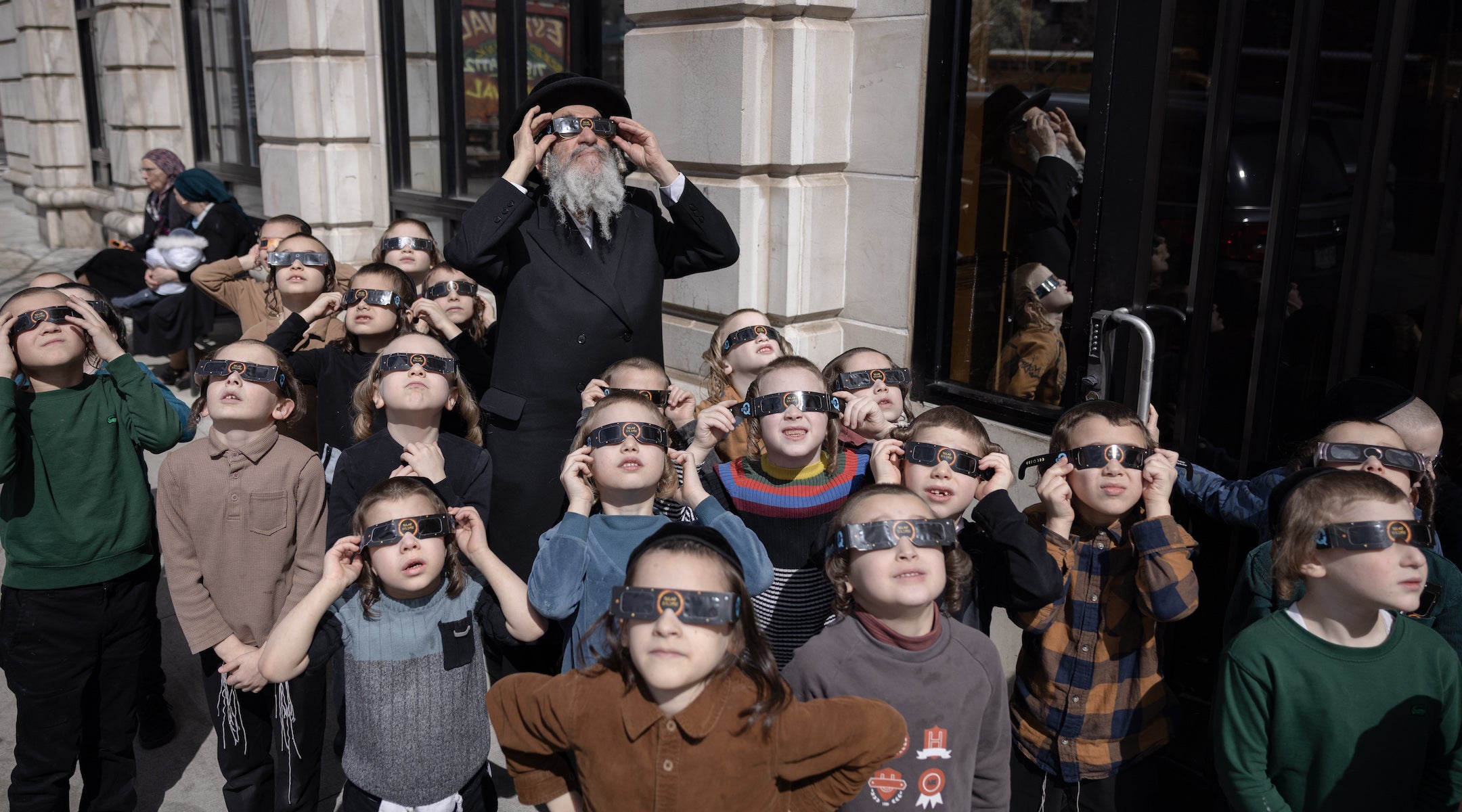
“Brooklyn Skies” by Abe Kugielsky. (Courtesy Abe Kugielsky)
What are you hoping people take away when they encounter your Grand Central exhibit?
What I’m expecting people to take away is really to see the humanistic side of this culture. People could be living literally a block away from the community, and not really know the community, and not understand them.
I’m hoping that this gives them a little bit more of a humanistic view of the Hasidic community, where they live, their life, their culture, their religion. After all, we’re all human, we all coexist in the same city.
—
The post How Abe Kugielsky’s photos of Hasidic Brooklyn ended up on display in Grand Central Terminal appeared first on Jewish Telegraphic Agency.
Uncategorized
The call of this Hanukkah moment remains simple and urgent: Light candles everywhere. Even when we’re under attack.
The massacre in Sydney has left Jews around the world shaken and grieving. This act is far more than a heinous crime: It is a regression to darker times, when Jewish visibility itself carried mortal risk.
The commandment of Hanukkah is not simply to light candles, but to light them publicly – pirsumei nisa, the publicizing of the miracle. The point is not private consolation, but shared visibility. Jewish survival, the tradition teaches, is not meant to occur behind closed doors, but in full view.
Historically, however, it rarely did. In exile, Jews learned caution. The Talmud records how, in times of danger, the candles are to be moved indoors – lit discreetly, shielded from hostile eyes. This was not a theological revision but a concession to reality: When the public sphere is unsafe, Jewish life retreats into the private domain. For most of our history, this was our reality.
Modern democracies promised something different. Jews would no longer have to choose between safety and visibility. We could light openly again – on windowsills, in public squares, in front of city halls – because the surrounding society would protect us not merely by law, but by norm. Antisemitism would not just be illegal, it would be unthinkable.
The Sydney massacre, alongside countless incidents in societies Jews have long trusted, forces us to ask whether that promise is still being kept.
Jewish safety in the diaspora does not rest primarily on police presence or intelligence services – necessary though they are. It rests on something more fragile and more fundamental: a public culture in which Jews are not merely tolerated but embraced; in which antisemitism is not merely condemned after the fact but rejected instinctively and unequivocally as a violation of the moral order.
When Jews are attacked for being Jews, and the response is muted, conditional, or delayed, the message is unmistakable. Jews may still live here, but only quietly.
That is why the response to Sydney must not be withdrawal, but the exact opposite. We cannot and will not retreat into hiding our light. The call of this moment is simple and urgent: Light candles everywhere.
Jewish communities and organizations must orchestrate public Hanukkah candle lightings in the central squares of democratic cities across Europe, across the English-speaking world, wherever Jews live under the protection of free societies. Not hidden ceremonies. Not fenced-off gatherings on the margins. But civic events, hosted openly and proudly, with the participation of local and national leaders – and of fellow non-Jewish citizens.
This is not unprecedented. Every year, a Hanukkah menorah is lit at the White House. The symbolism is powerful precisely because it is mundane: Jewish light belongs at the heart of the civic space, not as an exception, not as an act of charity, but as a matter of course. That model should now be replicated widely.
Israeli diplomatic missions, together with local Jewish organizations, should work actively with municipalities and governments to make these public lightings happen – not merely as acts of Jewish resilience, but as declarations of democratic commitment. Because this is not only a Jewish question.
A society in which Jews feel compelled to hide their symbols is a society already retreating from its own values. Antisemitism is never a stand-alone phenomenon; it is the canary in the democratic coal mine. Where Jews are unsafe, pluralism is already fraying.
Lighting candles in public squares will not undo the horror of Sydney. But it will answer it – not with fear, and not with silence, but with a refusal to normalize xenophobia, antisemitism, and Jewish invisibility.
The ancient question of Hanukkah – where we light – has returned as a modern moral test of democratic societies and leaders worldwide. Where Jewish light is extinguished, democracy itself is cast into shadow. If it can still be lit openly, with the full backing of the societies Jews call home, then the promise of democratic life remains alive.
Our light must not hide. Not now. Never again.
The post The call of this Hanukkah moment remains simple and urgent: Light candles everywhere. Even when we’re under attack. appeared first on The Forward.
Uncategorized
Australia shooting terrifies Jews worldwide — and strengthens the case for Israel
If the shooters who targeted Jews on a beach in Australia while they were celebrating Hanukkah thought their cowardly act would turn the world against Israel, they were exactly wrong: Randomly killing people at a holiday festival in Sydney makes the case for Israel.
The world wants Jews to disown Israel over Gaza, but bad actors keep proving why Jews worldwide feel such an intense need to have a Jewish state.
Think about it. The vast majority of Jews who settled in Israel went there because they felt they had nowhere else to go. To call the modern state “the ingathering of exiles” softpedals reality and tells only half the story. The ingathering was a result of an outpouring of hate and violence.
Attacking Jews is the best way to rationalize Zionism.
Judaism’s holidays are often (humorously) summarized as, “They tried to kill us, they failed, let’s eat.” Zionism is simply, “They tried to kill us, they failed, let’s move.”
Theodor Herzl, the founder of modern Zionism, didn’t have a religious or even a tribal bone in his body. He would have been happy to stay in Vienna writing light plays and eating sacher torte. But bearing witness to the rise of antisemitism, he saw the Land of Israel as the European Jew’s best option.
The Eastern European pogroms, the Holocaust, the massacre of Jews in Iraq in 1941 — seven years before the State of Israel was founded — the attacks on Jews throughout the Middle East after Israel’s founding, the oppression of Jews in the former Soviet Union — these were what sent Jews to Israel.
How many Australians are thinking the same way this dark morning?
There’s a lot to worry about in Israel. It is, statistically, more dangerous to be Jewish there than anywhere else in the world. But most Jews would rather take their chances on a state created to protect them, instead of one that just keeps promising it will – especially when the government turns a blind eye to antisemitic incitement and refuses to crack down on violent protests, as Australia has.
“For over a year we have seen racist mobs impeding on the rights and freedoms of ordinary Australians. We have been locked out of parts of our cities because the police could not ensure our safety. Students have been told to stay away from campuses. We have been locked down in synagogues,” Alex Ryvchin, the co-CEO of the Executive Council of Australian Jewry, wrote a year ago, after the firebombing attack on a Melbourne synagogue.
Since then a childcare centre in Sydney’s east was set alight by vandals, cars were firebombed, two Australian nurses threatened to kill Jewish patients, to name a few antisemitic incidents. There were 1,654 antisemitic incidents logged in Australia from October 2024 to September 2025 — in a country with about 117,000 Jews.
“The most dangerous thing about terrorism is the over-reaction to it,” the philosopher Yuval Noah Harari said. He was talking about the invasion of Iraq after 9/11, the crackdown on civil liberties and legitimate protest. But surely it’s equally dangerous to underreact to terrorism and terrorist rhetoric.
Israel’s destruction of Gaza following the Hamas attack of Oct. 7, 2023 led to worldwide protests, which is understandable, if not central to why tensions have escalated.
But condemning civilian casualties and calling for Palestinian self-determination — something many Jews support — too often crosses into calls for destroying Israel, demonizing Israelis and their Jews. That’s how Jews heard the phrase “globalize the intifada” — as a justification for the indiscriminate violence against civilians.
When they took issue with protesters cosplaying as Hamas and justifying the Oct. 7 massacre, that’s what they meant. And look at what happened in Bondi Beach, they weren’t wrong. Violence leads to violence, and so does support for violence.
Chabad, which hosted the Hanukkah celebration in Sydney, has always leaned toward a more open door policy with less apparent security than other Jewish institutions. But one of the reasons it has been so effective at outreach has also made it an easy target.
As a result of the Bondi shooting, Chabad will likely increase security, as will synagogues around the world. Jewish institutions will think hard about publicly advertising their events. Law enforcement and public officials will, thankfully, step up protection, at least for a while. These are all the predictable result of an attack that, given the unchecked antisemitic rhetoric and weak responses to previous antisemitic incidents, was all but inevitable.
It’s not inevitable that Australian Jews would now move to Israel, no more than it would have been for Pittsburgh’s Jewish community to uproot itself and move to Tel Aviv after the 2018 Tree of Life massacre. That didn’t happen, because ultimately the risk still doesn’t justify it.
But these shootings, and the constant drip of violent rhetoric, vandalism and confrontation raise a question: If you want to kill Jews in Israel, and you kill them outside Israel, where, exactly, are we supposed to go?
The post Australia shooting terrifies Jews worldwide — and strengthens the case for Israel appeared first on The Forward.
Uncategorized
These are the victims of the Bondi Beach Hanukkah celebration shooting in Sydney
(JTA) — A local rabbi, a Holocaust survivor and a 12-year-old girl are among those killed during the shooting attack Sunday on a Hanukkah celebration in Sydney, Australia.
Here’s what we know about the 11 people murdered in the attack, which took place at a popular beachside playground where more than 1,000 people had congregated to celebrate the first night of the holiday, as well as about those injured.
This story will be updated.
Eli Schlanger, rabbi and father of five
Schlanger was the Chabad emissary in charge of Chabad of Bondi, which had organized the event. He had grown up in England but moved to Sydney 18 years ago, where he was raising his five children with his wife Chaya. Their youngest was born just two months ago.
In addition to leading community events through Chabad of Bondi, Schlanger worked with Jewish prisoners in Australian prisons. “He flew all around the state, to go visit different people in jail, literally at his own expense,” Mendy Litzman, a Sydney Jew who responded as a medic to the attack, told the Jewish Telegraphic Agency.
Last year, amid a surge in antisemitic incidents in Australia, Schlanger posted a video of himself dancing and celebrating Hanukkah, promoting lighting menorahs as “the best response to antisemitism.”
The best response to antisemitism. Happy Chanukah! pic.twitter.com/33RSGYzhUY
— Rabbi Eli Schlanger (@SchlangerEli) December 17, 2024
Two months before his murder, he published an open letter to Australian Prime Minister Anthony Albanese urging him to rescind his “act of betrayal” of the Jewish people. The letter was published on Facebook the same day, Sept. 21, that Albanese announced he would unilaterally recognize an independent Palestinian state.
Alex Kleytman, Holocaust survivor originally from Ukraine
Kleytman had come to the Bondi Beach Hanukkah celebration annually for years, his wife Larisa told The Australian. She said he was protecting her when he was shot. The couple, married for six decades, has two children and 11 grandchildren.
The Australia reported that Kleytman was a Holocaust survivor who had passed World War II living with his family in Siberia.
12-year-old girl
Alex Ryvchin, co-CEO of the Executive Council of Australian Jewry, told CNN that a friend “lost his 12-year-old daughter, who succumbed to her wounds in hospital.” The girl’s name was not immediately released.
Dozens of people were injured
- Yossi Lazaroff, the Chabad rabbi at Texas A&M University, said his son had been shot while running the event for Chabad of Bondi. “Please say Psalms 20 & 21 for my son, Rabbi Leibel Lazaroff, יהודה לייב בן מאניא who was shot in a terrorist attack at a Chanukah event he was running for Chabad of Bondi in Sydney, Australia,” he tweeted.
- Yaakov “Yanky” Super, 24, was on duty for Hatzalah at the event when he was shot in the back, Litzman said. “He started screaming on his radio that he needs back up, he was shot. I heard it and I responded to the scene. I was the closest backup. I was one of the first medical people on the scene,” Litzman said. He added, “We just went into action and saved a lot of lives, including one of our own.”
The post These are the victims of the Bondi Beach Hanukkah celebration shooting in Sydney appeared first on The Forward.


